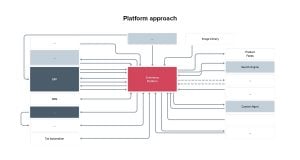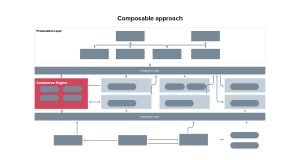“Should I shift to composable architecture or stick with a platform-based architecture for my ecommerce business?”
With new developments in the way digital commerce solutions work, many digital vendors are curious about the benefits of composable architecture.
In our 3-part series, we investigate headless commerce and composable architecture to help you make the right choice for your business.
In part 1, we discuss ecommerce evolution, to provide an in-depth understanding of these concepts.
CX Evolution
In the mid-2000s, digitalization was still in the early stages. Early ecommerce companies offered a single-channel experience, tied into siloed systems decoupled from their main business model.
Fast forward to the early era of omnichannel, around 2012-2013. An increase in consumer demand and the widespread adoption of smartphones pushed digital commerce forward quickly. Digital vendors began launching innovative omnichannel experiences left and right.
Now, businesses are investing heavily into constantly innovating and perfecting their digital CX. It’s not just about offering products via multiple channels, it’s about a deep customer understanding. Brilliant CX is about orchestrating relevant experiences at the right place and time, regardless of channel.
The current digital experience provides consumers with many more touchpoints than ever before in their purchase journey. That’s why the champions and industry leaders of tomorrow will meet the following criteria:
- The increased market dynamics, globalization, and changing buyer behavior are all driving a constant need to evolve. The leaders of tomorrow will have business agility, with the capability to rapidly adapt to new business models.
- The champions will deliver value through CX, by looking past the transaction and embedding themselves into the greater part of the user journey.
- The leaders will only be able to have business agility and deliver value through CX through the power of connected data and intelligence.
Here’s the issue–the increasing need for agility places a lot of pressure on your technology stack. You must be able to build new channels and re-calibrate your back office rapidly.
Ecommerce Architecture Evolution
To support this evolution, IT architectures must adapt.
Traditionally, the commerce platform contains the presentation layer or user interface, with all functionality in one codebase. While this kind of architecture is easy to set up, scaling and maintaining it can quickly become costly and confusing.
With backend and frontend codes in one codebase, making changes to code can come with unexpected consequences elsewhere. The line between backend and frontend developers becomes blurry, making teamwork harder and requiring more platform experience from developers.
Then came layered architecture. While traditional architecture is still frequently used, layered architecture started gaining traction in the late 90s. This type of architecture was developed to improve efficiency and re-usability. Autonomic layers were developed for presentation, functionalities, integration, and data.
However, the tight integration between the layers meant that changing one component would still require testing for its dependencies in the layers above and below. This solution was still not agile enough to meet the constantly changing needs of companies.
Enter composable architecture, which offers the high levels of flexibility, customization, and scalability needed by modern digital vendors.
Platform-Based Architecture vs Composable Architecture
Nowadays, the two main architecture types that ecommerce businesses are deciding between are platform-based and composable. While composable is new and exciting, it’s important to understand whether making the change is right for your business at the current stage.
Platform-Based Architecture
Platform-based architecture refers to a platform that’s built on a concept with a large set of well-proven out-of-the-box features that will be customized to meet business needs.
To use an analogy, take an iMac and a custom-built PC. The platform-based architecture follows a set of principles with an architecture that’s set by the manufacturer. It’s usually part of a larger ecosystem, which comes with benefits such as ease-of-integration, shared data models, and pre-built functionalities. Exactly as you would find in an iMac.
Platform-based architecture provides benefits if your needs fit with the functionality of the system. You can customize the systems, but just like with an iMac, you will reach a point where you must upgrade the whole system by replacing it with a “newer version.” Usually, a platform lifecycle is about 5-8 years.
Composable Architecture
Composable architecture is based on a microservices concept, wherein the different services and features are divided into agnostic building blocks that can operate independently from each other.
As composable architecture is based on a set of building blocks, you’re able to add, replace, and enhance parts of your system along the way. This provides endless flexibility. It allows you to optimize every part of your system and enables you to work on a more granular level of your architecture. In this scenario, you completely avoid large-scale re-platforming projects that can take 1-2 years every time. Similarly, a custom PC is made up of the best components hand-selected for the user, such as the motherboard, CPU, memory, and hard drives. You can replace or upgrade individual parts fairly easily to keep your machine in tip-top shape and “scale” to upgraded memory, CPU, and hardware.
As with a custom PC, composable architecture calls for a higher level of technical competence to ensure the right building blocks are assembled.


Visual Representation: Platform-Based Architecture vs Composable Architecture
In the visual above, the top diagram represents a single platform approach, while the diagram on the bottom illustrates the composable method. Look at the red block in each diagram; note that the commerce platform is the heart of the solution in the platform approach. However, in composable, the commerce engine has much fewer connections, with some components not connecting at all. In composable architecture, the commerce engine is no longer the center of the solution.
It’s not that the solution on the right is less complex (in fact such solutions tend to have more moving parts); it’s that each component is less connected to the architecture, which allows for significant flexibility. In software development, flexibility can be defined by how easy it is to remove a component; the less coupled it is to other parts, the easier it is to remove, and therefore, to change, replace, improve, and more.
Conclusion
Composable architecture is seen as the natural evolution of ecommerce. While it offers many benefits and digital businesses will move towards this model in the future, the platform-based approach is still the best fit for many organizations. It’s not easy to fully jump to a composable approach with an established ecommerce solution, nor is it the best choice for every digital vendor.
Join us for part 2 of the series to determine if composable architecture is a good fit for you, or contact our team to talk to professionals.
Be sure to check our on-demand webinar on the topic of composable and headless.








